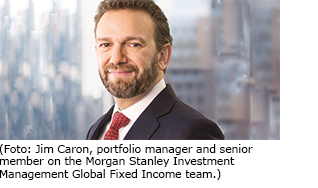
Morgan Stanley IM: Fixed Income Markets 2018 - A New Way to Value Assets
Traditional fundamental-based models may no longer be optimal for valuing fixed income investment opportunities. We need a new way to value assets, so Jima Caron, portfolio manager and senior member on the Morgan Stanley Investment Management Global Fixed Income team.
03.03.2018 | 12:44 Uhr
 As politics, regulation and policy become more dominant factors driving asset prices, traditional fundamental-based models may no longer be optimal for valuing fixed income investment opportunities. We need a new way to value assets. And we believe portfolios need to diversify these risk factors over an investment time horizon to help produce attractive and more consistent returns.
As politics, regulation and policy become more dominant factors driving asset prices, traditional fundamental-based models may no longer be optimal for valuing fixed income investment opportunities. We need a new way to value assets. And we believe portfolios need to diversify these risk factors over an investment time horizon to help produce attractive and more consistent returns.
Since the financial crisis, global central banks have found creative ways to generate easy policy, ranging from negative interest rates to quantitative easing. In order to support the financial system, these policies were designed to distort the valuation metrics of asset prices such that investors rebalance their portfolios into higher yielding, riskier and more distressed assets. Unfortunately, higher asset prices did not have the desired effect of increasing growth and inflation, which in turn made central banks hold on to these policies for too long.
The unintended consequence of their actions has been to make asset prices more responsive to policy than to economic fundamentals. As a result, traditional fundamental models have become poor forecasters of asset prices—for example, low levels of unemployment are not translating into higher wage inflation the way they used to. Similarly, the very strong levels of global manufacturing indexes, such as PMIs, are not translating into higher government bond yields.
Adding to the complexity of this condition is the larger role that politics are now playing in market volatility, what some may consider a disruptive change. Populism, regulation and de-regulation have become important market variables. These are not necessarily new risk factors, but what is unique is that their impact is being felt all at once. This has become a large source of price volatility.
Traditional financial models that were designed to translate economic fundamentals into financial asset prices are poorly equipped to handle the complexities of today’s market structure, where politics, regulation and policy have now become the dominant drivers of asset prices. We believe there is more noise than signal in today’s markets and that it is increasingly important to distinguish between the two when making investment and asset allocation decisions. Portfolio construction and an investment strategy that dampens noise and concentrates on signal can help identify investment opportunities in what are otherwise confusing markets.
At Morgan Stanley Investment Management, we turn what might be considered by some as disruptive change into opportunities by constructing portfolios that are designed to reduce noise and focus on signal. We make our investment decisions and design investment strategies accordingly to optimize performance potential. We possess the capability to adjust to the new dynamic while still holding true to fundamental economic principles, which we think is the right combination.



Diesen Beitrag teilen: